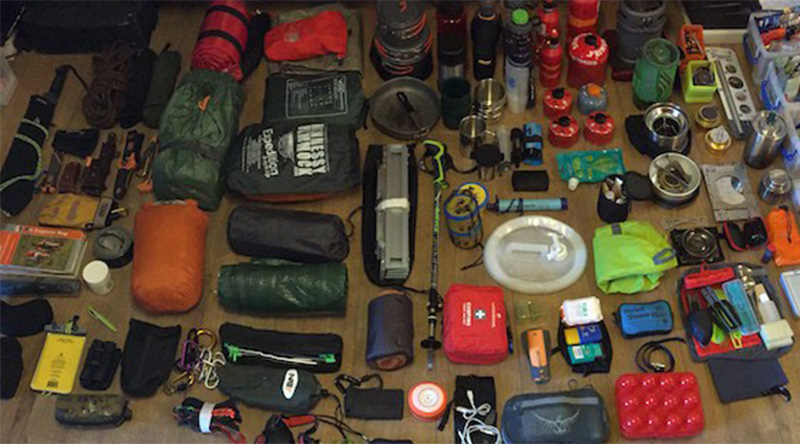The Optimum Load-Out
The ‘optimum load out’ is a phrase we have adopted from various sources, to mean the best collection of information, knowledge and equipment that you can gather to ensure that your adventure is comfortable and safe.
The most important phrase we use when packing for an adventure is “pack for the adventure, not every adventure…”.
When choosing what kit to take, the most important parameters to consider are weight, bulk and usability. The first two are obvious: if you’re only going to camp by your vehicle, neither are particularly a consideration, but if you are hiking 10 miles a day over hill-and-dale, they become of paramount importance. The third consideration is less obvious, but vital. In your kit list, what items have multiple functions or configurations: a 3m square tarp can be much more versatile than a tent in many situations, and take up far less room.
There are many more considerations when choosing the ideal piece of kit for any adventure, and there are many considerations when purchasing the optimum piece of kit to add to your ‘master kit list’.
The most important consideration when choosing your load-out is to remember that equipment alone is not going to keep you safe and comfortable. The knowledge of how to use that equipment is just as important as having it in the first place. If you carry the best kit available but don't know how to use it then it is little more than dead weight in your pack.
When thinking about your physical equipment you should always consider the following:
-
Have you thoroughly tested any new piece of equipment and made yourself properly comfortable in its use, especially in poor weather, the dark, driving rain and howling wind or all of the above.
-
Do you know how to maintain or repair it in the field, do you have the necessary tools and replacements (such as batteries) to keep it working, and can you perform the maintenance in difficult conditions? Changing torch batteries in the dark in an emergency quickly could save someone’s life.
- Do you know where everything is in your pack? Can you get to things in the dark or in an emergency when you need it most? Is it easily accessible if it is an emergency item, logically packed?
-
Do you have a spare for essential tasks, in case your main item fails irreparably? A second knife for example.
-
Have you left room for the luxuries in life? The purpose of adventuring is to enjoy the adventure, it shouldn’t be an ordeal, and having space in your pack to carry life’s little luxuries and things to record your adventure should be a key consideration.
-
Do you really need to take it? Having a first aid kit and the knowledge to use it is a given in every adventure. But taking a mountain trauma kit to a stroll through light forest may be somewhat over zealous. Taking a 2kg multi-tool shovel with built in USB charger may be top-of-the-line bragging rights, but will a small plastic shovel do the job just as well? A good tip is to go through your kit as soon as you get home and put to one side the items that you haven’t used that you thought you would. You may be surprised…
-
Leave space in your pack: we opt for the 70% 30% rule when packing. The 70% is the kit that you will use personally in your adventure, the 30% to take group provisions, collect interesting items as you explore, or just to make finding things easier in your rucksack.
The following are the key areas of the load-out that you should consider. it is important to remember that its not just what goes in your back-pack that is important, but how you prepare physically and mentally for your adventure.
| Area | Description |
|---|---|
|
Equipment |
What are the physical items you will need for your adventure? From clothes and cooking equipment, though to something to put it all in. |
| Mental | What training and mental preparation do you need to undertake in order to get the most from your adventure? |
| Physical | How should you prepare physically for your adventure in terms of physical fitness, diet and overall health? |
| Practical | What are the practical details to consider before taking your next adventure? How do you minimize the chance of something going wrong, and are you covered if something does? |
| Maintenance | Do you have the skills, tools and knowledge to maintain your equipment properly? Beyond physical equipment, are your skills up-to-date and practiced, such as First Aid? Is your kit in good shape so you can jump the back fence at a moment’s notice? |
| Purpose | The most important consideration of all. Why are you going on this adventure? What will you set out to achieve, what will you do when you get there, and how will you record it when you do? |

